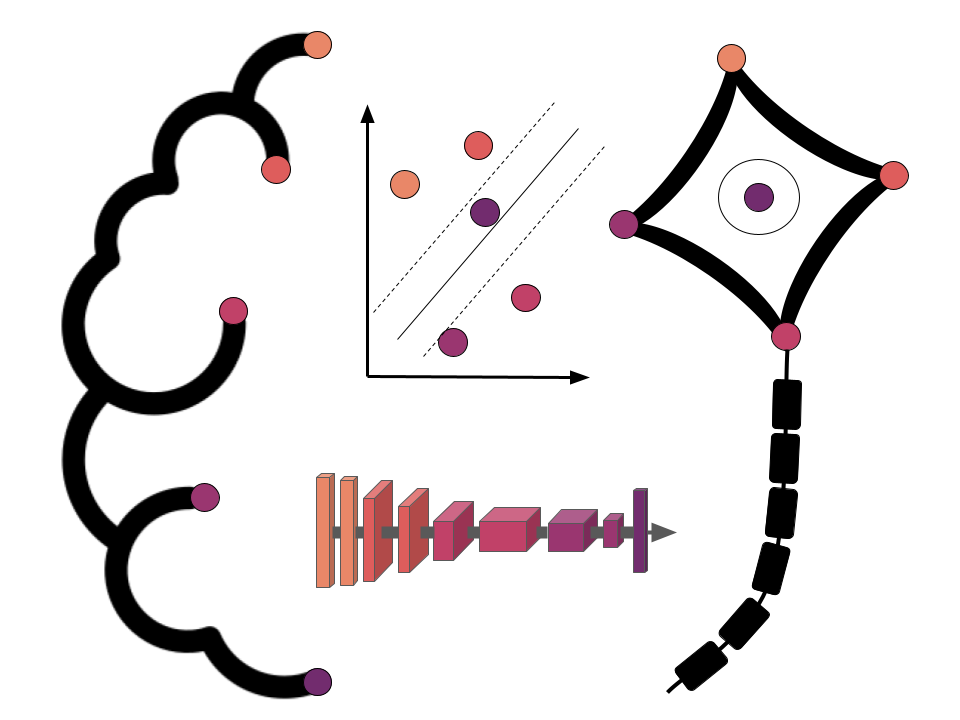Welcome!
Contents

Welcome!¶
Hello everyone and welcome to the course page for “Cognitive & computational neuroscience: an introduction to machine/deep learning and neuro-data-science”, taught within the Psychology Master programme of the Goethe-University Frankfurt during the spring term 2022. We’re glad to see you here!
Within these pages, we provide all the information important to follow and conduct the course, including formal aspects, requirements, lecture materials, practicals and so on. This jupyter book will include the used slides and code in a way that they can be explored in an interactive manner. You can navigate through the respective sections via the TOC on the left side and within sections via the TOC on the right side. The three symbols in the top allow to enable full screen mode, link to the underlying Github repository and allow you to download the contents as a pdf or jupyter notebook respectively. Some sections will additionally have a little rocket in that row which will allow you to interactively rerun certain parts of the practicals via cloud computing. Additionally, we support public reviews and comments through an hypothes.is plugin with which you can interact on the right side. All of this awesomeness (talking about the infrastructure and resource) is possible through the dedicated and second to none work of the Jupyter community, specifically, the Executable/Jupyter Book and mybinder project.
Cognitive & computational neuroscience: an introduction to machine/deep learning and neuro-data-science¶
No matter the scientific field: obtaining a solid understanding of and gaining substantial hands-on experience with research processes and workflows is crucial, with the intersection of neuroscience & artificial intelligence being no exception to that. Importantly, critical thinking & evaluation, research project management, quantitative & qualitative analyses, etc. enable a holistic approach to the exploration of this fascinating research field. But how should folks learn these things?
Traditionally, one way of achieving this is to familiarize students with all parts of the respective processes early on in their studies with an application to real-world problems and questions. More precisely, folks conduct several experiments, provided and self-chosen, within which they perform all or most of the necessary steps of the corresponding research workflow themselves, both in a guided and independent manner. Importantly, all of this will be conducted based on open science principles. This has several important reasons: addressing the faulty direction science and academia in via changing incentive structures (open methodology, open data, open access,open peer review), enable students to become active and self-sufficient parts of the research and scientific community via the sole utilization of open-source software and open educational resources, as well as increasing the diversity and inclusivity of science and academia via the diminution of hurdles and barriers: science by everyone for everyone in an open and welcoming manner.
As you can see in the TOC on the left sidebar, there’s quite a bunch going on here. You may ask: “Oh my, is all of this really necessary?”. Well, it might depend on who you ask but this course and the people conducting it think so and here’s why: creating a structured and holistic way to empirically train students via a complex framework needs time, effort, details, and dedication. Additionally, to increase openness and sustainability, and thus ultimately the success rate of projects, these things need to be prepared and supplied in a way that is findable, accessible, interoperable and re-usable (FAIR) for as many people as possible.
This course is therefore designed to provide only FAIR content and materials.
You can use the following sections to navigate through the content of the lecture:
-
What’s this course all about? How are things implemented and supposed to work?
-
What are the specific topics and aspects taught?
-
What do I need to follow and participate in the course?
An introduction to the intersection of neuroscience & artificial intelligence
All things gotta start somewhere and working in this research field is no exception to that, but how?
-
How to set up and conduct experiments to acquire data and subsequently analyze it?
-
How can you successfully generate insights from your obtained results and communicate those sufficiently?
-
Making sure the work and progress of the participants is transparent and documented.
-
Was it worth it and how can this be evaluated?
-
Necessities for creating an open, fair, safe and inclusive learning experience.
I’ve got a question!¶
In case you have any questions or difficulties with the lecture and its materials, please don’t hesitate a single second to get in touch. A great way to do this is to open an issue on the GitHub site of the course. Every feedback or idea or you might have is also highly appreciated and valued.
Acknowledgements¶
Peer Herholz’ work on and ability to compile this course was enabled through training received at the Montreal Neurological Institute, specifically the NeuroDataScience - ORIGAMI lab supported by funding from the Canada First Research Excellence Fund, awarded to McGill University for the Healthy Brains for Healthy Lives initiative, the National Institutes of Health (NIH) NIH-NIBIB P41 EB019936 (ReproNim), the National Institute Of Mental Health of the NIH under Award Number R01MH096906 (Neurosynth), a research scholar award from Brain Canada, in partnership with Health Canada, for the Canadian Open Neuroscience Platform initiative, as well as an Excellence Scholarship from Unifying Neuroscience and Artificial Intelligence - Québec.




